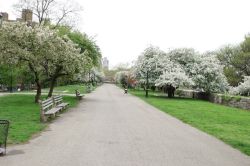Riverside Park
View all monuments in NYC Parks, as well as temporary public art installations on our NYC Public Art Map and Guide.
General Franz Sigel
| Artist: | Karl Bitter |
| Dedicated: | October , 1907 |
| Location: | Riverside Drive and West 106th Street |
Artwork History
This bronze equestrian sculpture of military officer, educator, journalist, and public servant Franz Sigel (1824–1902) is by the distinguished sculptor Karl Bitter (1867–1915). Sigel is also honored with a park named for him, located at 158th Street and the Grand Concourse in the Bronx.
Sigel was a patriot both in his native land of Germany and in his adopted home in the United States. He was born on November 18, 1824, in Sinsheim, Baden. He completed his studies at the Gymnasium of Bruchsal, graduated from the military academy of Karlsruhe in 1843, and then became a lieutenant in the grand ducal service. However, his liberal views were in conflict with the existing regime. After leading an unsuccessful revolutionary force in 1848, he was forced to flee to Switzerland. He traveled in exile to England in 1851, and then to the United States a year later.
After settling in New York City in 1852, he taught in public schools and German schools, co-founded the German-American Institute, joined the Fifth New York Militia, and wrote for the New Yorker, Staats-Zeitung, and the New York Times. He moved to St. Louis in 1857 to teach at the German-American Institute.
At the outset of the American Civil War, Sigel formed a regiment that helped to keep Missouri and its federal arsenal for the Union. Rising to the rank of major general in the Union Army, he fought in several decisive campaigns including Pea Ridge and the Second Battle of Bull Run. He is credited with encouraging many German-Americans to fight for the Union. Sigel returned to New York in 1867, first working in the transportation industry and then serving in various positions in local and federal government. He then resumed his career in journalism as the publisher of the New York Deutsches Volksblatt and editor of the New York Monthly. He died on August 21, 1902.
In 1904, a monument committee commissioned Karl Bitter to sculpt Sigel’s portrait. Bitter was born in Austria and trained in Europe before immigrating to the United States in 1889. He created numerous sculptures for wealthy private clients such as the Vanderbilts and Astors, as well as many public works of art, including the statue of Carl Schurz (1913) in Morningside Park. Before his death in a car accident, he modeled the maquette for the figure of Pomona atop the Pulitzer Fountain (1913-1916) in Manhattan’s Grand Army Plaza. His masterful portrait of Sigel was one in a series of sculptures he made of foreign-born American military heroes, including the Marquis de Lafayette and Baron Von Steuben.
With the Franz Sigel commission, Bitter took great care in determining its location at the top of a staircase where West 106th Street meets Riverside Drive. The granite pedestal projects beyond the top step and rests on a secondary stone base. It was dedicated in 1907. In 1941, Sigel’s bronze sword was dislodged and reattached by Parks crews, and was later removed to storage for safekeeping. Following conservation of the sculpture in 2004 by the Citywide Monuments Conservation Program—that included the reattachment of the long-salvaged sword—an endowment was established with Riverside Park Fund in memory of Thelma and Alex Schwarz to provide for the monument's care in perpetuity. Ongoing horticultural work along the adjoining hillside provided by Riverside Park Fund beautifies the setting of this historical monument.
Artwork Details
| Description: | Equestrian figure (over life-size) with integral plinth on a pedestal that rests on a base that allows the monument to sit at the top of a staircase |
| Architect: | William Welles Bosworth |
| Materials: | Bronze, Plymouth granite |
| Dimensions: | Figure H: 11'9"; Pedestal H: 6'3" L: 10' W: 5'8"; base H: 2'3" L: 10' W: 5'8" |
| Donor: | Sigel Monument Association |
| Cast: | 1907 |
Please note, the NAME field includes a primary designation as well as alternate namingsoften in common or popular usage. The DEDICATED field refers to the most recent dedication, most often, butnot necessarily the original dedication date. If the monument did not have a formal dedication, the yearlisted reflects the date of installation.
For more information, please contact Art & Antiquities at (212) 360-8163.
Check out your park's Vital Signs
Clean & Safe
Green & Resilient
Empowered & Engaged Users
Share your feedback or learn more about how this park is part of a
Vital Park System

Know Before You Go
Due to construction, as of September 23, 2024, Cherry Walk at Riverside Park is temporarily closed between West 100th Street and St. Clair Place (West 125th St). Please view our Temporary Greenway Detour map for an alternative route.
Anticipated Completion: Spring 2025
Related inquiries may be sent to boatbasin@parks.nyc.gov
Related inquiries may be sent to boatbasin@parks.nyc.gov






